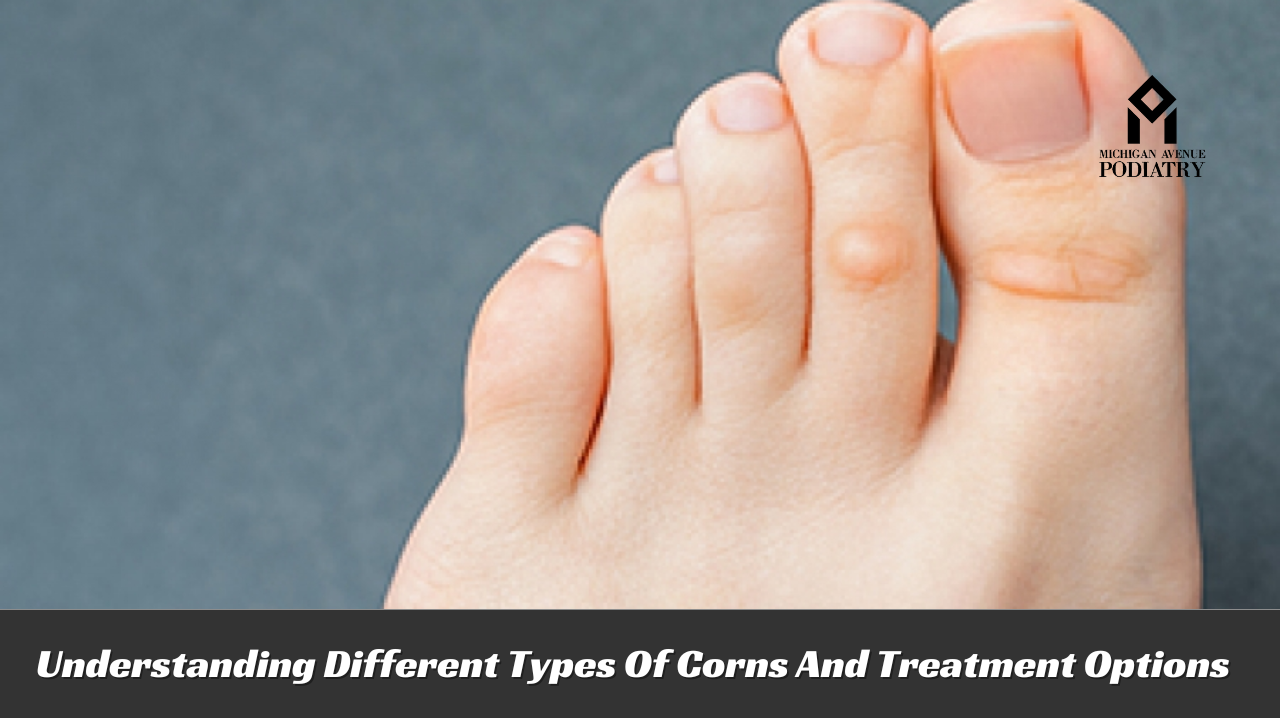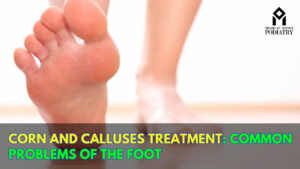Corns are a common foot condition that can cause discomfort and pain. They develop as a result of repeated pressure or friction on the skin, typically on the feet. Understanding the different types of corns and the various treatment options available is crucial for effective management and relief. This comprehensive guide will explore the types of corns, their causes, symptoms, and the most effective treatment options to help you maintain healthy and pain-free feet.
Types of Corns
Corns are categorized into three main types: hard corns, soft corns, and seed corns. Each type has distinct characteristics and requires specific treatment approaches.
1. Hard Corns
Hard corns, also known as heloma durum, are the most common type. They typically form on the tops of toes, the outer edge of the little toe, or the ball of the foot. Hard corns are characterized by a dense, thickened layer of skin with a small, hardened core at the center.
Causes:
- Tight or ill-fitting shoes that exert excessive pressure on specific areas of the foot.
- Abnormal gait or foot mechanics, leading to uneven distribution of pressure.
- Repetitive activities that cause friction, such as running or walking long distances.
Symptoms:
- A hard, raised bump on the skin.
- Pain or tenderness when pressure is applied.
- Dry, flaky skin around the corn.
2. Soft Corns
Soft corns, or heloma molle, usually develop between the toes, where the skin remains moist due to sweat. They are softer and have a rubbery texture compared to hard corns. Soft corns are often white or gray in color and can be quite painful due to the constant friction between the toes.
Causes:
- Tight shoes that squeeze the toes together.
- Excessive sweating, creating a moist environment between the toes.
- Repeated friction from footwear.
Symptoms:
- A soft, rubbery bump between the toes.
- Redness and inflammation around the affected area.
- Pain or discomfort, especially when wearing tight shoes.
3. Seed Corns
Seed corns are smaller and less common than hard and soft corns. They usually appear on the bottom of the feet and are often painless. Seed corns are small, round, and can be numerous, often mistaken for calluses.
Causes:
- Dry skin that leads to small, seed-like corns.
- Friction from walking barefoot or wearing poorly cushioned shoes.
- Pressure from underlying bone structure.
Symptoms:
- Small, round bumps on the sole of the foot.
- Typically painless, but can become tender if they develop in weight-bearing areas.
Treatment Options
Effective treatment of corns involves addressing the underlying causes and providing symptomatic relief. Here are several treatment options, ranging from self-care measures to professional interventions.
1. Self-Care Measures
Self-care measures are often the first line of treatment for corns. These methods aim to reduce pressure and friction on the affected areas, allowing the corns to heal naturally.
Footwear Modification:
- Choose shoes with a wide toe box to reduce pressure on the toes.
- Opt for well-cushioned shoes that provide adequate support.
- Avoid high heels and tight-fitting shoes.
Padding and Protective Coverings:
- Use corn pads or cushions to protect the affected area and alleviate pressure.
- Apply moleskin or foam pads to reduce friction between the skin and footwear.
Moisturizing and Exfoliation:
- Keep the feet moisturized to prevent dry skin and reduce the formation of hard corns.
- Regularly exfoliate the feet using a pumice stone or foot file to remove dead skin.
2. Over-the-Counter Treatments
Over-the-counter (OTC) treatments can be effective for managing mild to moderate corns. These products are easily accessible and can provide relief from discomfort.
Salicylic Acid:
- Salicylic acid is a common ingredient in corn removal products. It helps to soften and break down the thickened skin.
- Apply salicylic acid directly to the corn as directed on the product label.
- Be cautious when using salicylic acid if you have diabetes or poor circulation.
Hydrocolloid Dressings:
- Hydrocolloid dressings create a moist environment that promotes healing and reduces friction.
- These dressings can be particularly useful for soft corns between the toes.
3. Professional Treatments
For severe or persistent corns, professional treatments may be necessary. Consulting a podiatrist or healthcare professional can provide more advanced care.
Debridement:
- A podiatrist can safely remove the thickened skin of the corn using a scalpel. This procedure provides immediate relief from pain and pressure.
- Regular debridement may be needed for recurrent corns.
Orthotics:
- Custom orthotic devices can be prescribed to address abnormal foot mechanics and distribute pressure more evenly.
- Orthotics can prevent the recurrence of corns by providing better support and cushioning.
Cryotherapy:
- Cryotherapy involves freezing the corn with liquid nitrogen, causing it to blister and eventually fall off.
- This treatment is typically used for hard corns and is performed by a healthcare professional.
Surgery:
- In rare cases, surgical intervention may be required to correct underlying structural issues causing the corns.
- Surgery is usually considered a last resort when other treatments have failed.
Prevention Strategies
Preventing the formation of corns is essential for maintaining healthy feet. By adopting preventive measures, you can reduce the risk of developing corns and other foot-related issues.
Proper Footwear:
- Invest in high-quality shoes that fit well and provide adequate support.
- Rotate your shoes regularly to prevent excessive wear on specific areas of the foot.
Foot Hygiene:
- Maintain good foot hygiene by washing your feet daily and keeping them dry.
- Regularly moisturize your feet to prevent dry, cracked skin.
Regular Foot Care:
- Perform regular self-examinations of your feet to identify potential problems early.
- Schedule routine visits with a podiatrist to address any foot-related concerns.
Activity Modifications:
- Use cushioned insoles or pads when engaging in activities that place pressure on your feet.
- Take breaks and rest your feet during prolonged periods of walking or standing.
Conclusion
Understanding the different types of corns and the available treatment options is crucial for effective management and relief. Whether you opt for self-care measures, over-the-counter treatments, or professional interventions, addressing the underlying causes of corns and adopting preventive strategies can help maintain healthy and pain-free feet. By taking proactive steps, you can enjoy greater comfort and mobility, free from the discomfort of corns.


